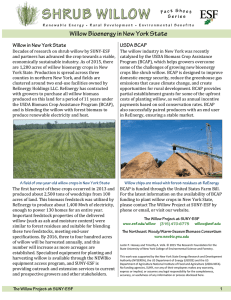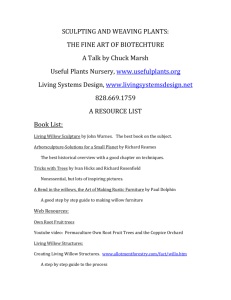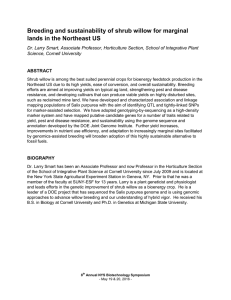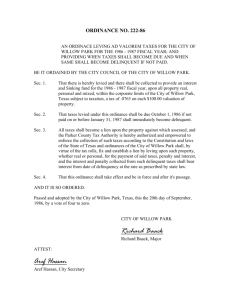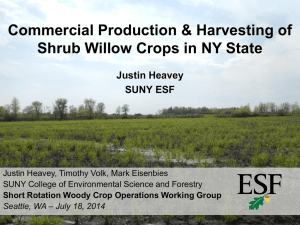BCAP Project Area 10: New York Willow Mike Buckley Tim Volk Justin Heavey
advertisement
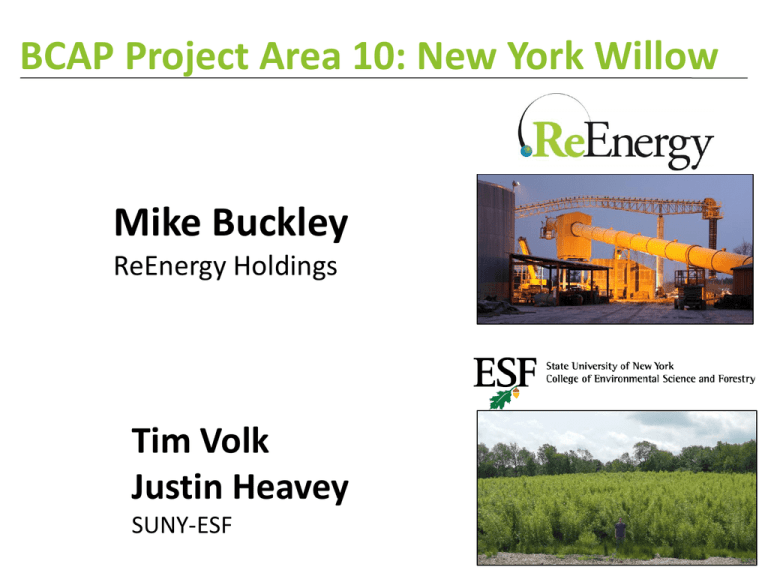
BCAP Project Area 10: New York Willow Mike Buckley ReEnergy Holdings Tim Volk Justin Heavey SUNY-ESF Fast Facts: ReEnergy Holdings • ~300 MWs of renewable energy generation • ~ 300 employees; 5 states Renewable Energy Facility Recycling Facility Headquartered in Latham, NY MA CT ReEnergy Holdings in New York • 80 employees • 103 MW of installed capacity, or 738,000 MWh – enough to serve 96,000 homes • $24 million in annual fuel purchases • Support more than 300 indirect jobs, most in the forest ReEnergy Facilities in NYS • ReEnergy Black River: 60 MW • ReEnergy Lyonsdale: 22 MW • ReEnergy Chateaugay: 21 MW ReEnergy Biopower • Large demand for woody feedstocks • Primarily forest residues • Recent contract with Fort Drum Army post; 100% renewable electricity for next 20 years Fuel Supply Program • End-market for BCAP Shrub Willow • Equipment Leasing Program o ReEnergy launched a program allowing loggers to gain access to state-of-the-art equipment and secure long-term agreements to provide fuel to ReEnergy • SFI Certification o First company solely devoted to electricity production to be certified by SFI o Commitment to use best management practices and protect forest health Commercial Willow Production • More than 3,100 tons of willow delivered to Lyonsdale and Black River facilities over first two harvest seasons, 2013 and 2014. YTD 2015: 1,200 tons. • Willow found to be suitable fuel in terms of moisture and ash content, now incorporated directly with other feedstocks upon delivery. • Current willow plantings are planned to be harvested about 350-400 acres per year. • This will produce roughly 8,000-9,000 green tons of feedstock annually Woody Biomass in Society World Energy Use – Increasing exponentially, mostly non-renewable sources Biomass Energy – 43% of all renewables world in US Projected Supply – 1,500 million dry tons per year by 2030 – 600 million from energy crops like willow Willow Genus (Salix spp.) Shrub willow Not tree willows! Salix purpurea, Salix miyabeana, Salix sachlinensis, Salix viminalis, Salix eriocephala, Salix caprea... …and many cultivars of these species (Salix babylonica) SUNY-ESF Willow Project Research on shrub willow since 1986 • • • • • • Cropping methods Breeding Yield Economics Best practices Environmental sustainability • Commercialization Why Shrub Willow? Unique plant characteristics Ease of establishment Regrows after each harvest 4-5 dry tons/acre/year Limited pests and diseases Willow in Central and Northern NY -About 1,150 acres in the ground -Harvesting about 350-400 acres per year -Delivered to ReEnergy biopower facilities -Mixed with forest residues -Renewable electricity Willow in Central and Northern NY Willow Crop Production Cycle Mechanized Planting -Specialized planter cuts large willow stems (“whips”) to about 10 inch “cuttings” and plants in one pass -Equipment and planting services are available from Celtic Energy and Double A Willow -Improved willow varieties available from Double A Willow -Orders for spring planting must be placed several months in advance Double-Row Planting Pattern 5,500 plants per acre 75% survival rate 2.5 foot Row spacing 6 foot Alley Spacing 2 foot Plant Spacing Three Years After Coppice Willow Harvesting New Holland forage harvester and 130FB header Developed by Case New Holland and SUNY-ESF from 2008 - 2012 Reduced harvesting costs by 35% (Eisenbies et al. 2014) Now available for purchase or rental EcoWillow Model • • Cash flow model Willow biomass crops • User-friendly & customizable • Recently updated using.. • • All phases of production • • Commercial operations Latest research studies Example production scenarios Download at: www.esf.edu/willow Economics of Production Base Case Scenario 2014 • • • Conservative estimates of profitability 22-year life cycle of the planting including tear-out Does not include best BCAP incentives or best practice targets Model Outputs • • Break-even scenario Payback is entire life cycle of project Economics of Production Base Case Scenario + BCAP Incentives • 2014 base case assumptions and 2015 BCAP funding Model Outputs • • • • Positive NPV IRR 10% Payback… o 10 years after planting o Third Harvest All-in costs about $25/ton Economics of Production Improved Base Case + BCAP Incentives • Adds current BCAP incentives and best practice targets to base case Model Outputs • • • • Positive NPV IRR 20% Payback o 7 years after planting o Second harvest All-in costs about $20/ton Willow Environmental Benefits • Carbon neutral lifecycle does not contribute to climate change • Low lifecycle herbicide/pesticide/fertilizer requirements • Perennial crop limits soil erosion and nutrient runoff • Revitalize idle or marginal lands • Wildlife habitat for birds and mammals • Creates jobs and rural development Potentially Available Land • Recent GIS analysis • 25-mile road network • ReEnergy Black River • 170,000 suitable acres o o o Hay/Pasture: 110,000 acres Row Crops: 40,000 acres Herbaceous/Scrub: 20,000 acres • Can be grown on marginal lands • Revitalize underutilized land base Willow Extension Services Training and education for BCAP willow… • Technical assistance • Outreach programs • Crop monitoring • Equipment access • Analytical tools & research summaries • Land assessments & consulting services Willow Summary Promising source woody of biomass Years of research at SUNY-ESF Positive economic returns with BCAP 1,150 acres already established Secure market in ReEnergy Environmental benefits Extension services available BCAP incentives for a limited time Thank You! Please contact us at… ReEnergy Holdings Michael Buckley bcap@reenergyholdings.com (518) 810-0200 Celtic Energy Farms Robert McDonagh celticenergyfarm@verizon.net (917) 796-7954 SUNY-ESF Justin Heavey jpheavey@esf.edu (315) 470-6775 Double A Willow Dennis Rak Dennis.Rak@doubleavineyards.com (716) 952-7023

